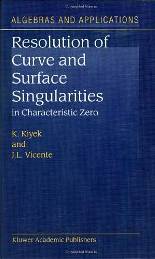Resolution of curve and surface singularities
Kiyek, k
Éditeur : KLUWER BOSTON
ISBN papier: 1402020287
Parution : 2004
Code produit : 1135031
Catégorisation :
Livres /
Science /
Mathématique /
Mathématiques
Formats disponibles
| Format | Qté. disp. | Prix* | Commander |
|---|---|---|---|
| Livre papier | En rupture de stock** |
Prix membre : 163,35 $ Prix non-membre : 171,95 $ |
*Les prix sont en dollars canadien. Taxes et frais de livraison en sus.
**Ce produits est en rupture de stock mais sera expédié dès qu'ils sera disponible.
Description
This book covers the beautiful theory of resolutions of surface singularities in characteristic zero. The primary goal is to present in detail, and for the first time in one volume, two proofs for the existence of such resolutions. One construction was introduced by H.W.E. Jung, and another is due to O. Zariski. Jung's approach uses quasi-ordinary singularities and an explicit study of specific surfaces in affine three-space. In particular, a new proof of the Jung-Abhyankar theorem is given via ramification theory. Zariski's method, as presented, involves repeated normalisation and blowing up points. It also uses the uniformization of zero-dimensional valuations of function fields in two variables, for which a complete proof is given. Despite the intention to serve graduate students and researchers of Commutative Algebra and Algebraic Geometry, a basic knowledge on these topics is necessary only. This is obtained by a thorough introduction of the needed algebraic tools in the two appendices.























